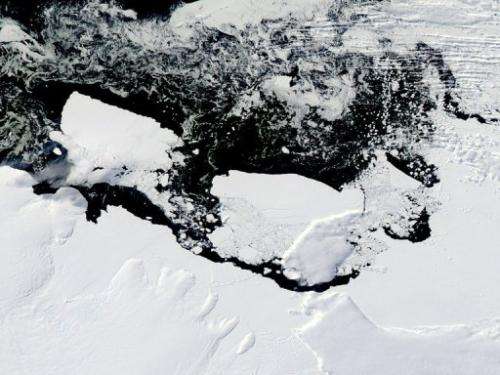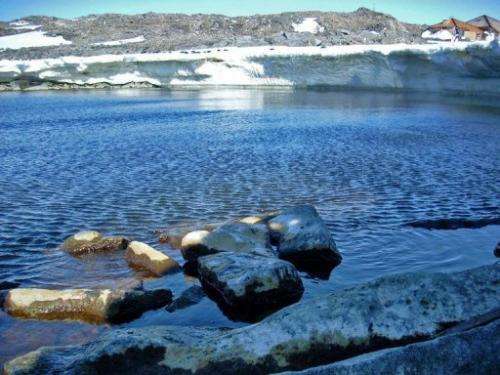A NASA image from 2010 shows Iceberg B9B (C), drifting along the coast of East Antarctica. The B9B iceberg, nearly 100 kilometres (60 miles), long is preventing tourist ships from reaching Antarctica to mark the centenary of Australian explorer Douglas Mawson's epic polar voyage.
An iceberg nearly 100 kilometres (60 miles) long was Wednesday preventing tourist ships from reaching Antarctica to mark the centenary of Australian explorer Douglas Mawson's epic polar voyage.
Mawson, among Antarctica's earliest pioneers, led the Australasian Antarctic Expedition between 1911 and 1914 -- an ambitious scientific research trip that laid Australia's territorial claim and presence on the icy continent.
He had been approached to join British adventurer Robert Scott's team in the race to the magnetic South Pole but Mawson declined.
Instead he set off from the city of Hobart on December 2, 1911 with his own men to pursue more scientific goals.
Mawson landed at Commonwealth Bay on January 8, 1912, building a complex of huts at Cape Denison that stand to this day.
Three tourist ships that have been attempting to reach the cape as part of 100-year commemorations of the legendary voyage had to ditch their plans due to rare conditions caused by the mammoth iceberg, an official said.
"There is unusual ice conditions that's affecting all the tourist ships that are going down there because the tourist ships don't have icebreaking capabilities, and they also don't have choppers," a spokeswoman from the Australian government's Antarctic division told AFP.
Commonwealth Bay in the Australian Antarctic Territory. An iceberg nearly 100 kilometres (60 miles) long was Wednesday preventing tourist ships from reaching Antarctica to mark the centenary of Australian explorer Douglas Mawson's epic polar voyage.
"So their ability to get anywhere near that Mawson's huts area is basically stopped."
The B9B iceberg, which is about the size of Luxembourg, is grounded at the cape's entrance and preventing what is known as fast ice -- sea ice frozen along the coast -- from moving as freely as normal, the spokeswoman said.
Calved from the Ross Ice Shelf in 1987, B9B made headlines last year when it smashed into the Mertz Glacier, creating a new iceberg which is so big it could potentially affect Earth's ocean currents and climate.
B9B is now in three major pieces and parts of it are frozen fast to the seabed, meaning it could clog Commonwealth Bay for up to a decade.
The Antarctic division spokeswoman said heavy pack ice -- dense floes that float on the water -- had also congested the area, compounding problems.
Mawson's original voyage battled thick pack ice, and Rob Easther from the Mawson's Huts Conservation Society said the tourists were experiencing authentic conditions.
"We refer to it as the 'A' factor, the Antarctic factor, it messes up a lot of people's plans," Easther told ABC Radio.
"That's what it's always done and it'll always do that. We'll never outsmart it.
"It's just part of operating in Antarctica and I know on the tourist vessels they make this clear to their passengers, even though they've paid lots of money to go," he added.
"A lot about Antarctica has not changed in the hundred years (since Mawson)."
The government vessel Aurora Australis is due to make its way for Cape Denison in early January for official commemorations of Mawson's voyage. It will be equipped with helicopters to fly passengers over the ice pack.
(c) 2011 AFP























